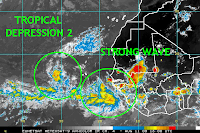

Tropical Depression 2 is hanging on for dear life today. Latest visible satellite imagery indicates that the low-level circulation remains intact. A small area of thunderstorms is firing just to the west of the circulation and has gained some coverage over the past few hours. However, strong easterly shear is keeping the convection from covering and wrapping around the circulation. Such an unfavorable environment is expected to persist over the next several days, so little intensifcation is expected. In fact, the global models all continue to weaken the system into an open wave. This will probably occur, although it may take a few days for the circulation to completely wind down. In any event, the depression or its remnants will continue to move westward and may bring some showers to the northeast Caribbean islands early next week.
The bigger story continues to be the tropical wave and its accompanied broad area of low pressure behind TD2, now formally designated Invest 90L. This low does not yet have organized deep convection, although it has fairly impressive upper-level outflow, particularly in the southern quadrant. Moreover, conditions ahead of this system are much more conducive than what TD2 faced, partially because TD2 itself has cleared a path for a more moist environment behind. Additionally, Invest 90L is further south, so not only will it face warmer ocean temperatures and heat content, but it will also encounter less shear and dry air. Not surprisingly, all of the noteworthy global models are showing this becoming a significant tropical cyclone over the next seven days, including the typically conservative UKMET.
Of course, the main concern will be in the future track. The system is currently being steered westward by a mid-level high pressue. This feature will remain the dominant steering mechanism for the next three days. Afterward, global models indicate that a high-latitude trough will dig between the Maritimes and Azores and erode some of the ridge across the north Atlantic. This will likely induce a more northerly component to the system's movement. How much of a northerly component occurs is still in question, and depends largely on how far west the system is at the time of the ridge erosion. The GFS and ECMWF, the two more reliable global models, represent the two extremes in forward motion over the next week. The GFS shows a quicker motion, and thus the system only bends just a little to the west-northwest. As a result, the cyclone impacts the northeast Caribbean islands in seven days. The ECMWF, on the other hand, shows a very slow forward motion in the next 48 hours, which allows it more time to feel the influence of the trough. The ECMWF therefore takes it well north of the Caribbean islands. The CMC and UKMET lie in between these two solutions. Given the current forward speed of the system and the synoptic flow already in place, the GFS solution is probably closer to reality than the ECMWF solution. Tropical cyclones in this area in recent years also tended to move slightly quicker than the model consensus. Therefore, a track very close to the northeast Caribbean islands toward late next week is the favored scenario at this time. Residents of the Lesser Antilles, as well as Puerto Rico and Hispaniola, are advised to closely monitor the progress of this developing storm.
It is difficult to pinpoint where the cyclone will track beyond the seven-day timeframe. However, there are some important clues to note. The GFS ensembles, the operational GFS, and the operational ECMWF all agree on an anomalous trough to set up over the eastern US beginning around day 7. In fact, they have all consistently showed this feature for the past several days, so confidence is high that there will be a trough over or near the eastern US at the end of next week. Moreover, they are also in agreement on locking the trough in place, with very little progression by day 10. There is some discrepancy on where exactly the trough sets in, and how much ridging builds downstream. These details will be crucial in determining where the said tropical cyclone tracks in the long-range. The position of the tropical cyclone itself in seven days will also be important. In any event, the system will probably recurve at some point due to the trough. Over the coming days there will hopefully be a better and more concise grasp on the system's future.






































